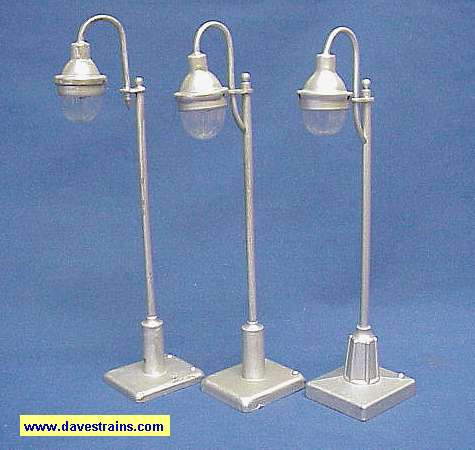www.davestrains.com
 Soviet Lamp Post
Soviet Lamp Post  |
|---|
| Home | Site Map | Postwar Lionel | Soviet Trains | Train Shows | Contact Us |
 Soviet Lamp Post
Soviet Lamp Post  |
|---|

About This Accessory
Every Stalin-era and Khrushchev-era train set produced by the Soviet Union in the 1950's and 1960's included three (stand-alone) gooseneck-type lamp posts. These silver-painted and rather-ornate street lights were made of metal with a glass globe covering a 13.5-volt bulb. When energized, the design from the lines cast into the glass helps produce a very unusual glow. This item was first made in 1951 and after undergoing two design changes in its history was last produced in 1969. The Soviet sets also included a beautiful passenger station which incorporated most of the parts of the gooseneck lamp on each of the two front corners.
| Photo of three different Lamp Posts |
|---|
 |
| Left & Center: Early style - - - Right: Later style |
Variations
--- Early Style (1951-1957)
The early-style Soviet lamp posts have a relatively plain base and pedestal which
are similar to the base and pedestal of the early-style
block signals. Although the overall
design appears to be a simple one, a close examination reveals many individual parts which
resulted in complicated manufacturing and assembly operations. The base, pedestal and
pole were separate parts that had to be swaged or fused together plus the lamp socket had to be
wired to the terminal block. In addition, the terminal connection block was attached with
screws and the light itself consisted of a glass globe, spring and metal collar
-- all of which had to be twisted onto the lamp cover! Two different designs of the early-style
lamp posts have been found:
--- First Generation (1951 only?)
The first generation, early-style Soviet lamp posts have a base that is
1/4 inch high, a pole and pedestal that combined, totals 8
1/4 inches to the decorative ball and an overall height of 10
1/8 inches. The gooseneck tube -- which holds the lamp housing and glass
globe -- is threaded through the collar that is attached to the pole and ends in a fancy
downward-pointed cone. The light socket wire is partially exposed as it goes through a slot in
the collar which holds the gooseneck tube. Three of these first generation, early-style lamp
posts were found in a 1951 "pre-production" set and appear to be very rare. Curiously, the
first generation lamp posts were depicted in the very first instruction manuals and continued
to be shown until the later-style lamp posts were illustrated. In other words, the second
generation, early-style, stand-alone lamp posts were NEVER SHOWN in the catalogs! (The second
generation, early-style lamp posts, however, were shown in the illustration of the passenger
station starting with the instruction manual dated September 23, 1958.)
--- Second Generation (1951? - 1957)
The second generation, early-style Soviet lamp posts have a base that is
3/8 inch high, a pole and pedestal that combined, totals 8
1/4 inches to the decorative ball and an overall height of 10 inches.
The gooseneck tube is threaded through the collar and is fused into the pole. This design
allowed the light socket wire to be hidden from view. A one-piece decorative ball and cap sits
on the top of the pole.
The early-style lamp posts -- which only came in Stalin-era sets -- were still being
produced in the first quarter of 1957 and possibly for several months after that. The earlier
(plainer) lamp posts are much harder to find than the later ones.
--- Later Style (1958-1969)
The later-style Soviet lamp posts have a fancier base and pedestal as compared to
the early-style lamp posts. (The later-style base and pedestal are similar to the base and
pedestal of the later-style block signals.) The design change resulted in a more attractive
accessory as compared to the earlier one and -- since the base and pedestal on the later-style
lamp posts were cast or molded parts -- it also simplified the manufacturing and assembly
operations. Although the wiring and the rest of the assembly operations described above
remained the same, it had to be a less costly item to make. The overall height is 9
7/8 inches -- slightly smaller than the early-style lamp posts.
The later-style lamp posts came in the later Stalin-era sets and all of the
Khrushchev-era sets. The later-style lamp posts have been found with a 3rd quarter of 1958 date
but initial production may have started a few months before that. They were first depicted in
the September 1958 instruction manual.

This page is an information document only; nothing on this web page is being offered for sale. This page and all of the other pages from Our Soviet Archives were developed to assist you in understanding the components of the train sets produced in the Soviet Union during the 1950's and 1960's. These sets are known today as "Stalin-era" sets and "Khrushchev-era" sets. We have used pictures from our old files and personal collection to construct this area of our website. If you are interested in buying something, please view our inventory listings to see what we currently have for sale.
This web page was last updated on September 9, 2005. If you have suggestions for improving this page or if you see any errors, please contact us.
| Trains From the SOVIET UNION | ||||
|---|---|---|---|---|
| Background: | Introduction | Component List | Archives Menu | FAQs & Glossary |
| Items For Sale: | Engines & Cars | Accessories | Other Items | Complete Sets |
| Home | Site Map | Postwar Lionel | Soviet Trains | Train Shows | Contact Us |
